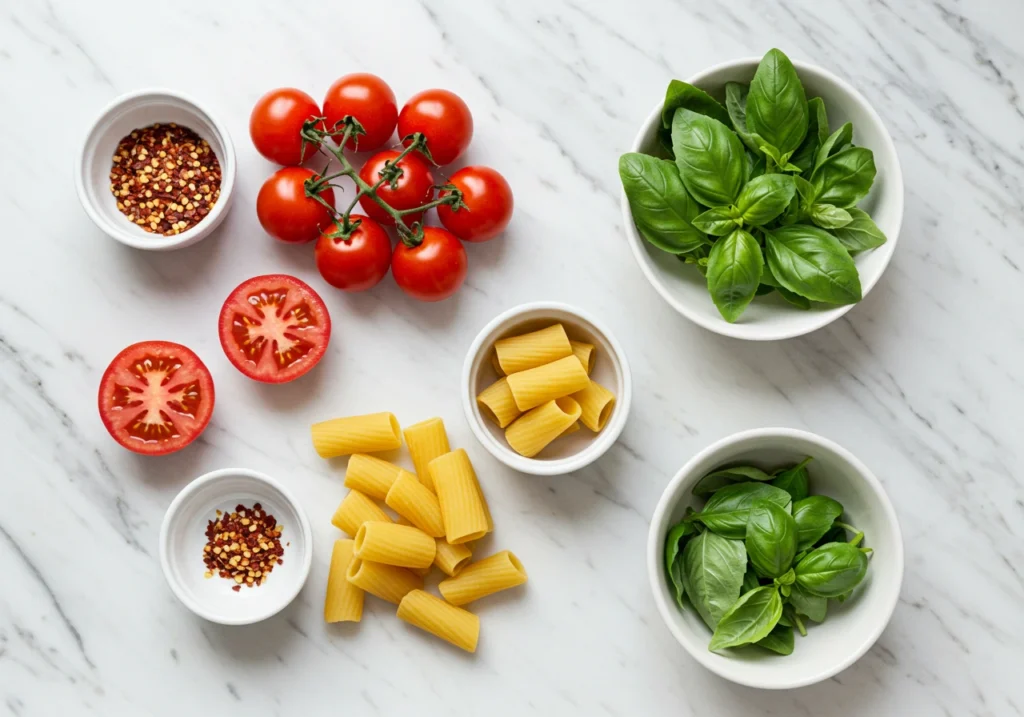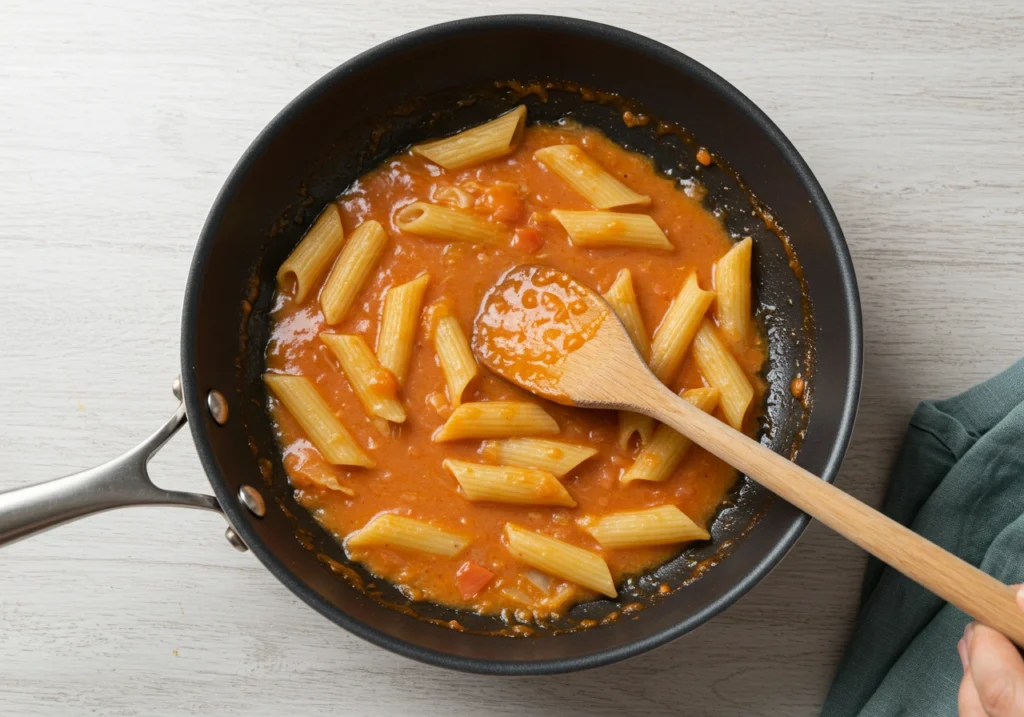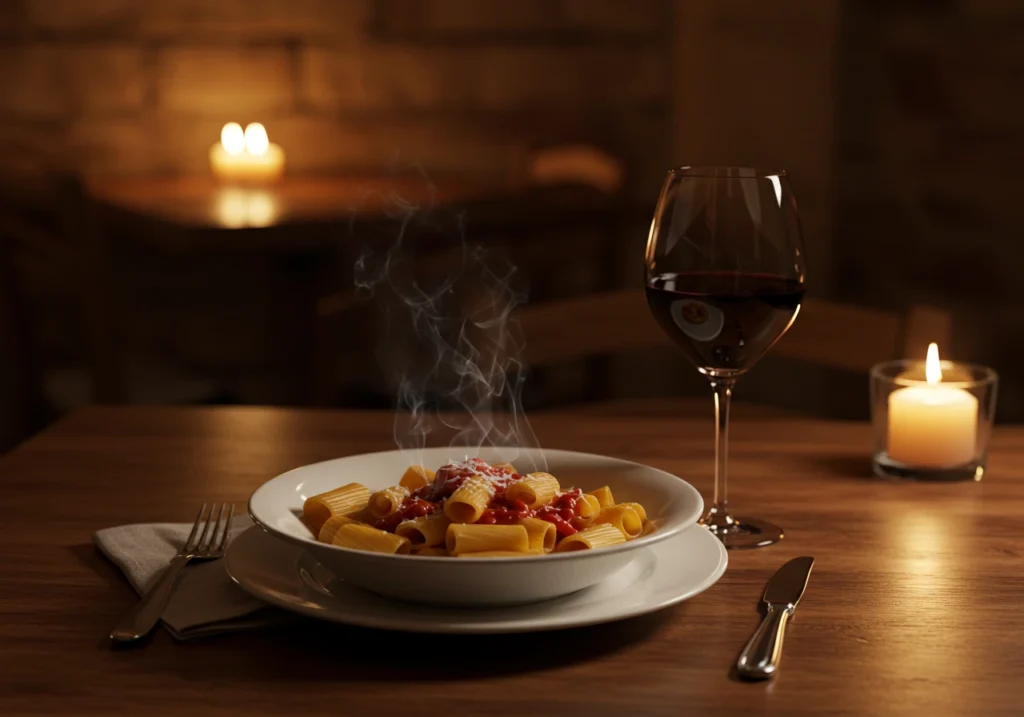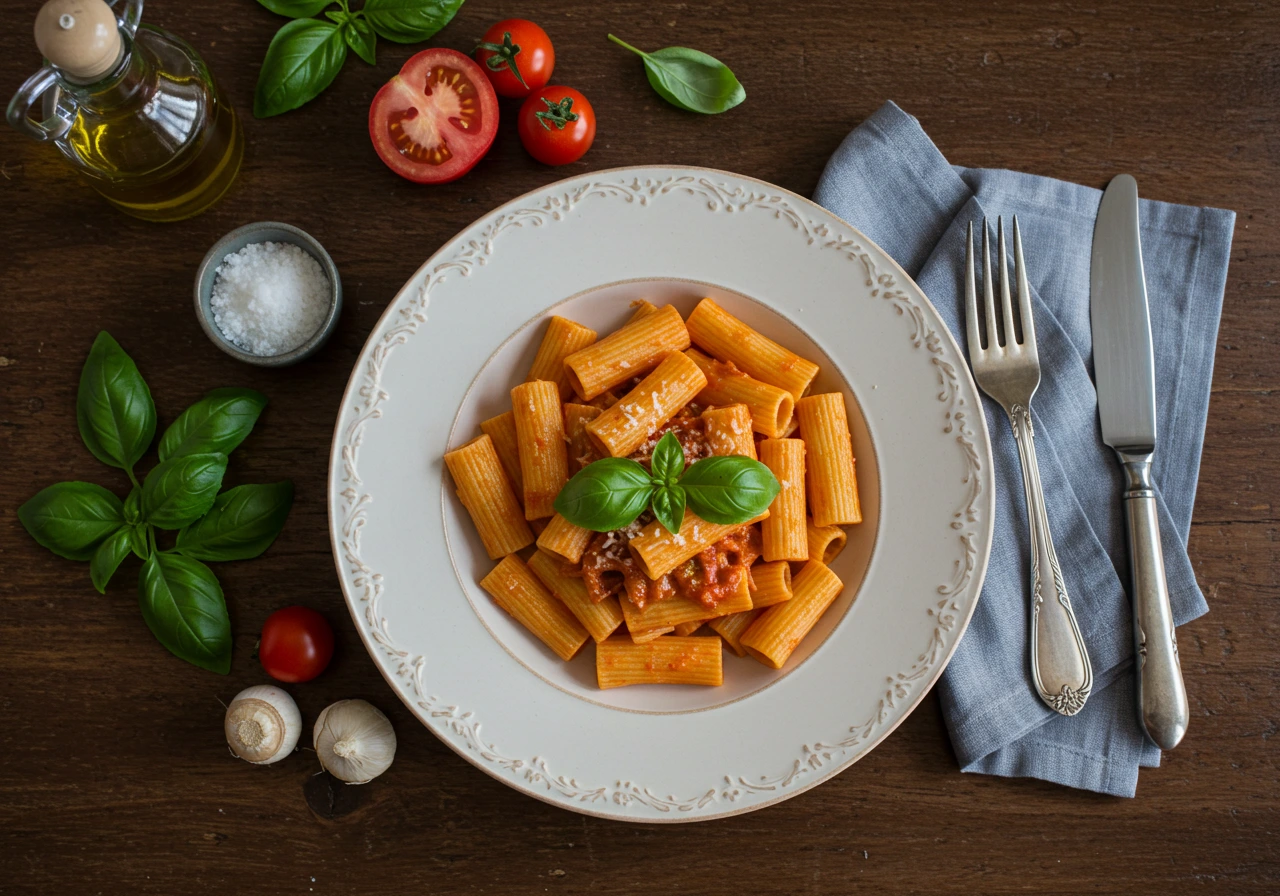Introduction to the Ultimate Spicy Rigatoni Experience
When you think of indulgent, flavorful pasta that practically melts on your tongue—what comes to mind? For many food lovers, it’s the Carbone Spicy Rigatoni Recipe. Originally made famous by the high-end New York hotspot Carbone, this creamy, peppery rigatoni dish has taken the culinary world by storm—and for good reason.
Whether you’re a pasta purist or a saucy spice-lover, recreating this masterpiece at home can bring a taste of luxury right into your kitchen. This article walks you through everything—from the history behind the sauce to step-by-step cooking tips and substitutions you’ll love. Plus, I’m sharing my personal take after trying the recipe myself (spoiler: it was divine!).
Part 1: Carbone Spicy Rigatoni Recipe – A Culinary Delight
Introduction to Carbone’s Signature Dish
Once upon a time in the heart of NYC’s Little Italy, a classic Italian-American restaurant called Carbone flipped the script on creamy tomato pasta. The Carbone Spicy Rigatoni took a humble noodle and elevated it with a velvety, fiery vodka sauce, packed with depth and personality. Unlike traditional rigatoni alla vodka, this dish combines luxury and heat—making it unforgettable.
As soon as it debuted, it blew up. TikTok influencers were raving. Food bloggers were re-creating it. Heck, I even had to elbow my way through the dinner crowd at Carbone just to try it. And guess what? Totally worth it.
Now, the good news? You don’t have to wait months for a reservation to taste this creamy, spicy joy. With the right tips, you can whip up this iconic recipe right at home—no culinary degree needed.
Personal Experience with the Recipe
I’ve always been a pasta lover, but this one? It’s on another level. The moment I took my first bite, I could taste the layers—the tangy tomato paste, the sweet cream, the subtle zing of garlic, and oh, that spicy kick from Calabrian chili paste. It’s bold, rich, and addictive.
The sauce clings to the rigatoni like it was born for it. And that’s not by accident—rigatoni’s ridges are sauce magnets. My version came out so close to the restaurant’s, I nearly cried (happy tears, of course). And that was without fancy ingredients or tools—just smart technique, good quality basics, and patience.
Plus, I played with spice levels to suit my family’s preferences. Some like it hot, others not. Thankfully, this dish is super customizable—you’re in full control.
So, if you’re curious about diving into this restaurant-worthy experience at home, keep reading. Trust me, you won’t want to miss a single detail.
The Origins of Spicy Rigatoni
Ah, spicy rigatoni—the fiery, creamy comfort food that’s as trendy as it is timeless. But where exactly did this bold and saucy creation begin? Like most great dishes, it’s the result of a flavorful fusion—one part old-school Italian soul, and the other, pure New York attitude. The origins of spicy rigatoni tell a story rooted in cultural mashups, accidental discoveries, and restaurant brilliance that turned a modest pasta into an icon.
History of Vodka Sauce in Italian-American Cuisine
To understand spicy rigatoni, we first need to dive into its creamy base: vodka sauce. It’s a bit of a culinary mystery. While some folks swear it was invented in Italy, most experts agree that vodka sauce is a proud product of Italian-American innovation. It popped up in New York during the 1970s or early ’80s—depending on who you ask—and was likely designed to marry the tanginess of tomato with the smoothness of cream.
But wait, vodka? Really?
Yes! Even though it’s mostly cooked off, vodka helps release flavor compounds from the tomato, enhancing the richness of the sauce. It’s science meets flavor. The dish quickly became a staple in Italian-American homes and restaurants because it had the perfect trifecta: simple ingredients, rich taste, and a crowd-pleasing look.
Initially, this creamy sauce was paired with penne, making penne alla vodka the OG. But things were just getting spicy…
Carbone’s Contribution to the Dish’s Popularity
Enter Carbone—a retro-glam Italian-American restaurant opened in 2013 by chefs Mario Carbone and Rich Torrisi. The place is known for old-school charm with white tablecloths and tuxedoed waiters, but it’s their Spicy Rigatoni Vodka that stole the show.
What Carbone did was genius: they upgraded the sauce with Calabrian chili paste for heat, intensified the tomato flavor with rich paste, and swapped penne for rigatoni—the superior noodle when it comes to sauce-hugging power. The result? A dish that was silky, spicy, savory, and unforgettable.
Social media went wild. Celebrities, influencers, foodies—they all craved a bite. Soon, it wasn’t just a menu item—it became a movement. People didn’t just want to eat it. They wanted to recreate it, master it, make it their own. And that’s where you come in.
By reimagining vodka sauce and turning up the heat, Carbone made a classic into a modern-day legend.
Ingredients Breakdown
Let’s face it: even the most well-written recipe is only as good as the ingredients behind it. In the case of the Carbone Spicy Rigatoni Recipe, every component plays a vital role in delivering that unforgettable, creamy kick. This isn’t just a matter of tossing pasta with tomato sauce—nope. We’re talking about carefully layered flavor, the kind that comes from choosing the right pasta, the right spice, and the right balance of richness.
So before we dive into the pot, let’s break down the soul of this dish, ingredient by ingredient.

Pasta Selection: Why Rigatoni?
If pasta were a red carpet event, rigatoni would be the best-dressed guest. Bold, ridged, and sturdy, rigatoni doesn’t just sit prettily on the plate—it gets in there and grabs hold of the sauce like a boss.
Unlike smooth spaghetti or slick penne, rigatoni’s wide tubes and ridged texture create pockets of flavor in every bite. That means every forkful carries the silky, spicy sauce straight to your tastebuds—no bland bites here!
Plus, its al dente chew gives that satisfying, toothsome texture that contrasts beautifully with the creamy sauce. It’s no wonder Carbone made it their pasta of choice. They knew: if you want the sauce to shine, the rigatoni must rise.
The Role of Calabrian Chili Peppers
Spicy rigatoni wouldn’t be spicy without its superstar: Calabrian chili peppers. Grown in the southern tip of Italy, these ruby-red beauties pack both heat and flavor. And unlike plain old crushed red pepper flakes, Calabrian chilies bring a smoky, fruity complexity that makes the dish sing.
In the Carbone version, the chili is usually added as a paste or oil. Just a spoonful deepens the sauce, adding layers of heat that don’t just burn—they bloom. You feel the warmth first on your tongue, then in your cheeks, then all the way in your belly. It’s comfort with a kick.
And if you’re sensitive to spice? No worries—you can adjust the amount without sacrificing flavor. That’s the magic of using a chili that’s rich, not raw.
Importance of Tomato Paste and Vodka
Here’s where we start building that luscious, restaurant-style sauce. Tomato paste isn’t just any tomato product—it’s a flavor bomb. Deeply concentrated, slightly sweet, and rich in umami, it sets the stage for a sauce that feels way more luxurious than your average marinara.
Then comes vodka. Now, don’t worry—we’re not making a cocktail. The vodka here serves a totally different purpose. It helps emulsify the tomato and cream, giving the sauce its smooth, velvety finish. Plus, it pulls extra flavor out of the tomatoes, giving the dish more depth.
The trick? Let the alcohol cook off before adding cream. You’ll get all the magic without the boozy bite.
Related: Read more about the history of vodka sauce and how it blends science with flavor →
Dairy Components: Heavy Cream and Parmesan
No creamy pasta is complete without dairy, and this one leans into it with confidence. The two MVPs? Heavy cream and Parmesan cheese.
Heavy cream provides the smooth, lush texture that makes every bite feel indulgent. It tames the heat from the chili, balances the acidity of the tomato paste, and ties everything together with buttery goodness. No substitutes—trust me, you want the real thing here.
And the Parmesan? Oh, baby. Grated Parm adds nutty saltiness, thickens the sauce slightly, and brings that unmistakable umami hit. It’s the finisher, the flavor booster, the crown jewel. Use freshly grated if you can—it melts better and tastes a thousand times more intense than the pre-shredded stuff.
Step-by-Step Cooking Instructions
Now comes the moment we’ve all been waiting for—bringing the Carbone Spicy Rigatoni Recipe to life in your own kitchen. Get ready to transform a handful of humble ingredients into something chef-level delicious. And don’t worry if you’re not a pro in the kitchen—this guide is foolproof. With a few simple steps and a little patience, you’ll be sitting down to a bowl of pure, spicy, creamy bliss before you know it.
Let’s walk through each step of the process, from prep to plating. Spoiler: it’s gonna smell amazing in here soon.

Preparing the Ingredients
First things first: let’s get prepped like the pros. Mise en place—that’s fancy talk for “everything in its place”—will make this a breeze.
Grab your cutting board and measure out your ingredients:
- 12 oz rigatoni pasta
- 2 tablespoons olive oil
- 3 cloves garlic, minced
- 1 tablespoon Calabrian chili paste
- 1 tablespoon tomato paste
- ¼ cup vodka (optional or substitute with a splash of broth)
- ¾ cup heavy cream
- ½ cup grated Parmesan cheese
- Salt and pepper to taste
- Fresh parsley or basil for garnish (optional)
Having everything measured and chopped ahead of time means less stress and more joy while cooking. Trust me—this one moves fast!
Cooking the Pasta to Al Dente Perfection
Next up: pasta. Bring a large pot of salted water to a rolling boil. That “salty like the sea” thing? Totally true—it makes a difference.
Toss in your rigatoni and stir occasionally to prevent sticking. Follow the package instructions, but shave off a minute or so—you want it just a touch al dente, which means firm to the bite. Why? Because the pasta’s going to finish cooking in the sauce.
Before draining, scoop out a cup of the pasta water and set it aside. That starchy liquid gold is your ticket to a silkier sauce later. Drain the pasta, but don’t rinse it—you want all that starch to cling to the sauce like a magnet.
Crafting the Spicy Vodka Sauce
Okay, now the magic really begins.
Heat the olive oil in a large skillet or sauté pan over medium heat. Add the minced garlic and sauté for about 30 seconds—just until fragrant, not brown.
Next, stir in the Calabrian chili paste and tomato paste. Cook them down together for about 2–3 minutes, stirring constantly. This step deepens their flavor and removes that raw edge.
Pour in the vodka (or your broth substitute) and let it simmer for another 2 minutes. This will deglaze the pan and reduce the sharp alcohol notes, leaving just the flavor complexity.
Now, lower the heat and slowly stir in the heavy cream. Watch as the sauce blushes into that perfect orange-pink shade. Keep stirring until everything is silky smooth.
Once your cream and tomato base are beautifully blended, add a generous pinch of salt and pepper, and let it gently bubble for 3–5 minutes. You want the sauce thick but pourable, glossy but not greasy.
Then, stir in the Parmesan cheese, letting it melt and melt until the sauce is glossy and rich. You should see it coat the back of your spoon. That’s when you know—it’s go time.
Combining Pasta and Sauce
Add the cooked rigatoni directly into the sauce. Toss and stir gently to coat every tube in that spicy, creamy goodness.
If the sauce feels too thick, gradually add a splash or two of the reserved pasta water. This step helps emulsify the sauce, making it clingy and dreamy.
Let the pasta simmer in the sauce for 1–2 minutes. This helps it absorb flavor and finish cooking perfectly. It’s the final fusion of ingredients—and boy, does it smell like heaven.
Final Touches and Serving Suggestions
You made it—now let’s make it pretty (and tasty)!
Plate your rigatoni generously, then sprinkle with extra Parmesan, a dash of Calabrian chili oil (if you’re feelin’ fiery), and a few torn leaves of fresh basil or parsley. For texture, add a few cracks of black pepper on top.
Serve it hot, with a side of crusty bread or a simple salad if you like. But honestly? This dish doesn’t need much. It shines all on its own.
And that first bite? Oh baby—it’s creamy, spicy, savory, and just the right amount of indulgent.
Nutritional Information
Let’s be real for a second—Carbone Spicy Rigatoni is comfort food through and through. Creamy? Yes. Rich? Absolutely. Calorie-light? Well… not quite. But that doesn’t mean you can’t enjoy it without a side of guilt. Whether you’re tracking your macros or just curious about what’s going on behind the scenes, this section gives you the full scoop.
Understanding the nutritional content helps you make better choices—whether that means portion control, adding a healthy twist, or just appreciating what goes into every satisfying bite. Let’s break it down!
Caloric Content and Macronutrient Breakdown
On average, one serving of spicy rigatoni alla Carbone—assuming a traditional prep with rigatoni, cream, Parmesan, and olive oil—clocks in at around 650 to 750 calories. The final count depends on portion size and cheese quantity (no judgment if you go heavy there, by the way).
Here’s a rough breakdown per serving:
| Nutrient | Amount |
|---|---|
| Calories | 700 kcal |
| Carbohydrates | 60–65g |
| Protein | 15–18g |
| Fat | 35–40g |
| Saturated Fat | 15g+ |
| Fiber | 3–4g |
| Sugar | 5–7g |
The heavy hitters? Definitely the cream and cheese. They provide most of the fat and saturated fat, while the pasta gives you a carb boost. It’s a meal that satisfies both your taste buds and your energy needs, especially after a long day.
Healthier Alternatives and Modifications
Don’t want to go full indulgence mode? No problem. You can still enjoy a spicy rigatoni recipe that’s lighter but still packs serious flavor.
Try these simple swaps:
- Use whole wheat or chickpea pasta: Adds more fiber and protein without sacrificing texture.
- Sub in Greek yogurt or coconut cream: A lighter dairy option that still delivers creaminess.
- Reduce the cream: Use half the amount and loosen the sauce with a splash of pasta water.
- Load up with veggies: Sautéed mushrooms, spinach, or roasted red peppers add volume, color, and nutrients.
- Skip or lessen cheese: Parmesan is potent—you can still get its punch with less.
And if you’re watching sodium, opt for low-sodium tomato paste and limit the added salt. Even cutting small things makes a big difference over time.
So yes, this dish can be a guilty pleasure or a smart splurge—it just depends on how you plate it.
Tips and Tricks for the Perfect Dish
Cooking isn’t just about following steps—it’s about finding the sweet (or spicy) spot where flavor, texture, and aroma all come together like a perfectly tuned symphony. When it comes to mastering your own version of the Carbone Spicy Rigatoni Recipe, a few small adjustments can take your dish from “pretty good” to “drop-dead delicious.”
Whether you’re cooking for a date night, meal-prepping for the week, or just treating yourself, these kitchen-tested tips and tricks will help you get it just right—every single time.

Achieving the Ideal Sauce Consistency
Let’s not beat around the bush—the sauce is everything. It should be rich, velvety, and cling lovingly to each tube of rigatoni. So, how do you nail that perfect texture?
Here’s what works:
- Use tomato paste, not canned tomatoes—this ensures a deep, bold flavor without making the sauce watery.
- Simmer the sauce gently, especially after adding the cream. Rushing this step can cause separation or a greasy layer on top.
- Add reserved pasta water gradually. It helps loosen the sauce without diluting the flavor and encourages it to emulsify beautifully.
- Toss the pasta in the sauce for at least 1–2 minutes over low heat. This marriage of pasta and sauce is key to making it feel like one cohesive dish.
Think silky, not soupy—your rigatoni should glide, not swim.
Adjusting the Spice Level to Taste
This one’s personal. What’s “mild” to you might be five-alarm fire to someone else. That’s why one of the best things about homemade spicy rigatoni is the ability to customize the heat.
Here’s how:
- Start with less chili paste, and add more as you taste. You can always kick it up, but you can’t take it back!
- Mix in a touch of sugar or extra cream if you overdo the heat. It balances things without muting the spice entirely.
- Want subtle heat? Use chili-infused oil instead of paste—it brings flavor with less punch.
- Cooking for kids or spice-sensitive guests? Skip the chili and let diners drizzle their own spicy oil on top.
In short: You’re in control of the flame!
Pairing Suggestions: Wines and Side Dishes
Even though the Carbone Spicy Rigatoni Recipe is a star on its own, smart pairings can elevate the entire dining experience. And no, it doesn’t need to involve wine (but we’ll mention a safe alternative!).
Here are great go-withs:
- Side salad with lemon vinaigrette – The acidity cuts through the creaminess beautifully.
- Roasted or sautéed greens, like broccolini or spinach – Adds bitterness to balance the richness.
- Garlic bread or focaccia – To mop up every last drop of sauce. (Seriously, don’t let that go to waste.)
- Sparkling water with citrus – Refreshing, palate-cleansing, and a perfect substitute for wine.
For a full-blown dinner moment, serve it in warm bowls and top with fresh herbs and cracked pepper. Your guests will be impressed—and you’ll feel like a kitchen boss.
Frequently Asked Questions (FAQs)
Still curious about the legendary Carbone Spicy Rigatoni Recipe? You’re not alone. This dish has stirred up a serious buzz—from home kitchens to food blogs to celebrity Instagram stories. Whether you’re wondering about its origins, heat level, or how much it’ll cost you at the actual restaurant, these answers will clear up the mystery and spice up your knowledge. Let’s tackle some of the most asked questions surrounding this viral pasta.
What sauce does Carbone use for spicy rigatoni?
Carbone’s spicy rigatoni is drenched in a spicy vodka tomato cream sauce, which has become nothing short of iconic. The base of the sauce includes tomato paste, Calabrian chili paste, vodka, and heavy cream, combined to create a bold yet silky flavor explosion. Unlike a typical marinara or a light tomato sauce, this version is intensely rich and layered with heat. The Calabrian chili brings a deep, smoky spice, while the vodka enhances the tomato’s aroma and helps the cream blend smoothly. The result? A sauce that clings like a dream and tastes unforgettable.
What is a famous Carbone dish?
Although the spicy rigatoni has taken social media by storm, Carbone’s menu is filled with other well-known dishes that reflect its Italian-American roots. One standout is their Veal Parmesan, served with dramatic flair and a sizzling layer of mozzarella. Another fan favorite? The Caesar alla ZZ, prepared tableside for a show-stopping start to any meal.
However, it’s the Spicy Rigatoni Vodka that steals the spotlight. It’s become synonymous with the Carbone name and is widely considered their signature dish. Its viral fame and delicious depth make it not just popular—but legendary. No visit to Carbone is complete without it.

What makes rigatoni spicy?
The heat in spicy rigatoni comes from Calabrian chili peppers, a signature ingredient in Carbone’s version. These southern Italian chilies are known for their bold, slightly smoky heat and complex flavor profile. At home, they’re often added in paste or oil form to sauces to provide consistent, controllable heat.
In some versions of the dish, you’ll also find a touch of crushed red pepper flakes to build the burn slowly. Combined with rich dairy and tangy tomato, the spice is softened into a delicious warmth that lingers instead of overwhelms. It’s that perfect balance of heat and comfort that keeps people coming back.
How much is Carbone Spicy Rigatoni?
If you’re dining in at Carbone NYC, get ready to splurge a little. As of recent menus, the Spicy Rigatoni Vodka dish typically costs around $32 to $36 USD—a price that reflects both its fame and its flavor.
Sure, it’s not your average Tuesday night pasta. But for many fans, it’s worth every penny for the rich sauce, the impeccable texture, and the whole elevated experience. That said, recreating the recipe at home? Now that’s value—because you can enjoy multiple servings of this restaurant-quality masterpiece for a fraction of the price.
Bringing the Taste of Carbone to Your Kitchen
There’s something truly magical about recreating a restaurant-famous dish in the comfort of your own kitchen. The Carbone Spicy Rigatoni Recipe isn’t just another pasta dish—it’s a flavorful, fiery love letter to Italian-American cuisine. And guess what? You’ve now got all the tools and tips to make it your own. From selecting the right ingredients to mastering that velvety sauce, you’re officially ready to serve up a dish that’s bold, beautiful, and absolutely unforgettable.
Let’s take one final look at what we’ve cooked up together.
Recap of the Cooking Experience
You started with simple ingredients—rigatoni, tomato paste, Calabrian chili, cream, and cheese—and turned them into a show-stopping, crowd-pleasing meal. You learned the art of sauce-making, how to balance spice, and how to pull everything together into a dish that tastes like it came straight out of Carbone’s kitchen. Not to mention, you got pro-level tips on texture, presentation, and smart ingredient swaps. All of that, from your own stovetop? Pretty impressive if you ask me.
Encouragement to Experiment and Enjoy
Now that you’ve nailed the classic, don’t be afraid to make it your own. Want it spicier? Go for it. Craving a dairy-free twist? Try a coconut cream swap. Cooking should feel like play—not pressure. And honestly, every attempt makes you a better home chef.
Whether you’re feeding a table full of friends or treating yourself to a quiet night in, this dish delivers comfort and wow-factor in equal measure. So go ahead—plate it up, take that first bite, and pat yourself on the back. You’ve just recreated one of the most beloved pasta recipes on the planet. Bravo!
Let me know if you’d like me to prepare internal linking strategies, outbound anchor suggestions, or social media captions to promote your article!

